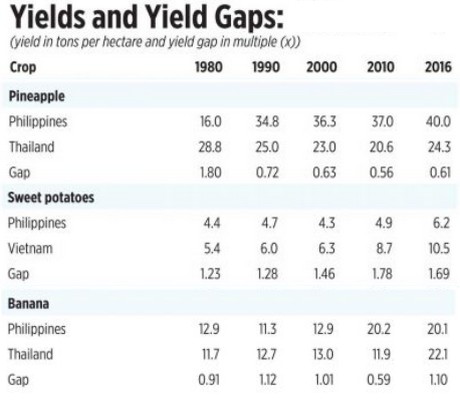Benchmarking compares yield parameters with “best-in-class” in the ASEAN
To provide empirical evidence, the productivity of key crops over the past 36 years were compared and gaps determined using data from the Food and Agriculture Organization (FAO). Ten major crops were covered, namely: rice, corn, coconut, sugarcane, banana, coffee, pineapple, cassava, sweet potato, and rubber.
A key finding is that the Philippines trails its peers in all crops, except pineapple and banana. Thanks to the private sector for these competitive industries. The gaps even widened over time in most crops. There is a nuance that are not revealed by the FAO data:
• Banana yield is slightly lower than Thailand’s. It is the native varieties (i.e., lakatan and saba) that depress the overall yield. Cavendish yield is 2.5 times the national yield.

The persistent low farm productivity severely affects the local agri manufacturing industry: low capacity utilization and limited new investments because of raw material constraints. These, in turn, affect job creation and processed exports. A major unintended consequence is the import of goods, such as coffee, cocoa paste, cassava, palm oil and rubber.
Altogether, the low yields affect impact on the competitiveness of agribusiness from farming, processing and exports. They heavily exacerbate rural and national poverty incidence. The compression of potential of consumer markets is enormous with limited buying power of the masses.
The solutions to address low yield levels and costs include: research and development, provincial extension hubs, farm credit, irrigation, market intelligence, land access rural infrastructure as well as private sector driven commodity road maps. These are known to experts in the academia, the private sector, the donor community and government.
Source: BusinessWorld







